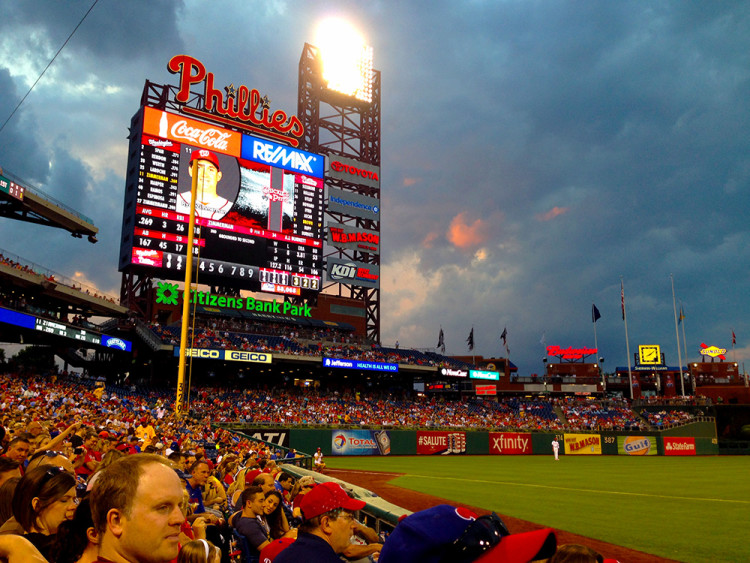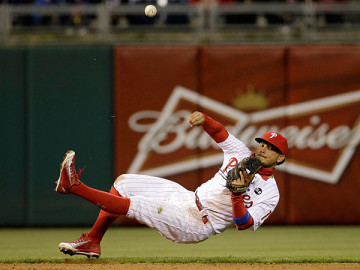 It is hard to think. Briefly, I wonder if they pump the smells of cooking meat into the crowd. Bad rock n’ roll and rap play during batting practice and between batters. The music is so loud you must lean over to talk to the person in the seat next to you. Not counting the ones beneath and above us, eight screens flash continuous displays, the giant being a 76 foot by 97 foot ‘television’ hovering over left field that runs stats, photos, fancams, amusements and replays. Couples are prompted to kiss when their images appear and families to smile and wave. The screen never shows the same grouping twice. Technicians appear to be scrupulous in letting their cameras roam unseen over everyone and in then choosing a pleasing configuration to show to all of us. Of all the shots this night, only one person seems displeased to be chosen, a lone young man in the upper deck, bundled against the cold, surrounded by empty seats, working diligently on his scorecard for the game. He finally looks up when some call out to him. He shakes his head and looks away.
It is hard to think. Briefly, I wonder if they pump the smells of cooking meat into the crowd. Bad rock n’ roll and rap play during batting practice and between batters. The music is so loud you must lean over to talk to the person in the seat next to you. Not counting the ones beneath and above us, eight screens flash continuous displays, the giant being a 76 foot by 97 foot ‘television’ hovering over left field that runs stats, photos, fancams, amusements and replays. Couples are prompted to kiss when their images appear and families to smile and wave. The screen never shows the same grouping twice. Technicians appear to be scrupulous in letting their cameras roam unseen over everyone and in then choosing a pleasing configuration to show to all of us. Of all the shots this night, only one person seems displeased to be chosen, a lone young man in the upper deck, bundled against the cold, surrounded by empty seats, working diligently on his scorecard for the game. He finally looks up when some call out to him. He shakes his head and looks away.
Citizen’s Bank Park is designed for maximum drama and maximum distraction. All of the seats seem to have good sight lines to the field, and its light stanchions and the curves of its decks are pleasing to the eye. It feels like a homerun hitter’s park; during batting practice Braves’ players were cracking balls in looping shots into the concession stands in deep right field. The balls reach the fence in one blink — crack, flick, gone. Aligning itself with American’s primary recreation, shopping, there is a mall in left center. Customers can stroll and eat and buy and eat and drink and eat and occasionally catch portions of the game. The stadium’s design implies that baseball is no longer the fundamental attraction — the spectacle is the hook. In the outpouring of images and sound from all those screens and speakers, and in the pull of shops and dozens of food concession stands, everything seems devised to keep fans moving, ever restless, operating in a kind of low-key consuming frenzy. It requires real effort to keep one’s attention centered on the field.
At ancient Connie Mack Stadium, rats sometimes ran along the girders overhead, the bathrooms reeked and looked like the scene of an urban horror movie, and one might choose between tough hot dogs and stale peanuts, but like all the old ballparks it was surrounded by homes. It felt as if it belonged in one place only, North Philadelphia. When you walked out of the concourses and into the bowl of the field, you almost gasped at the astonishing intensity of the green grass. One came for the game, only for the game. As with all the parks built since the 70’s, Citizens Bank’s location was chosen for easy automobile access. It looms among huge parking areas and next to football and basketball arenas. It could be anywhere.
 The game itself remains beautiful, even watching a bad team as the Phillies are this year. This is the same — the intricate balance of 10 moving bodies on each play; the complex interplay between pitcher, batter and catcher; the way a fastball tracks toward the hitter — how does anyone ever make contact except by accident? How does the pitcher not blow out his rotator cuff on each pitch? The wonderful arches fly balls make when they loop into the outfield. Now that the steroid era is past, the players again look like leopards and gazelles, their athleticism possessing a combination of power and elegance. They move so gracefully; even the swings of the power hitters have a lilting smoothness to them as if their motions have been greased to run frictionless on a track that curves upward. When Ryan Howard hit a two run home run to dead center field, it looked as if all he had done was turn on the ball and twist his wrists, and the ball rose at great speed, Newton’s Third Law riding and riding on the great noise of the crowd, and the ball finally coming down, the back of the Brave centerfielder straight, his head frozen into the descent.
The game itself remains beautiful, even watching a bad team as the Phillies are this year. This is the same — the intricate balance of 10 moving bodies on each play; the complex interplay between pitcher, batter and catcher; the way a fastball tracks toward the hitter — how does anyone ever make contact except by accident? How does the pitcher not blow out his rotator cuff on each pitch? The wonderful arches fly balls make when they loop into the outfield. Now that the steroid era is past, the players again look like leopards and gazelles, their athleticism possessing a combination of power and elegance. They move so gracefully; even the swings of the power hitters have a lilting smoothness to them as if their motions have been greased to run frictionless on a track that curves upward. When Ryan Howard hit a two run home run to dead center field, it looked as if all he had done was turn on the ball and twist his wrists, and the ball rose at great speed, Newton’s Third Law riding and riding on the great noise of the crowd, and the ball finally coming down, the back of the Brave centerfielder straight, his head frozen into the descent.
One play locked itself into my mind’s eye — a well hit ground ball snaking to the left of the Phillies’ shortstop, Freddie Galvas, and after two steps he took off parallel to the ground, and he flew — he flew — and stopped the ball, pivoted like some Bronx thirteen year old doing hip-hop moves on the street, all boneless and impossible, and he flipped, and as he completed the turn, he threw to first base, his body’s torque giving him the force to make the throw and get the runner. Ohh, ohh, how lovely! Moments like it do lift us beyond every disturbance. How often do we witness something so pure?
A great, recent baseball book: Throwback by Jason Kendall
So of course my question is…… What did you have to eat? Ha!
Excellent . . .